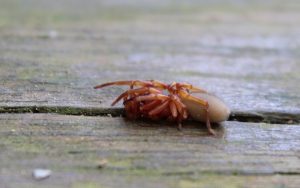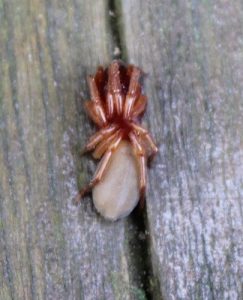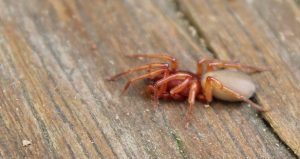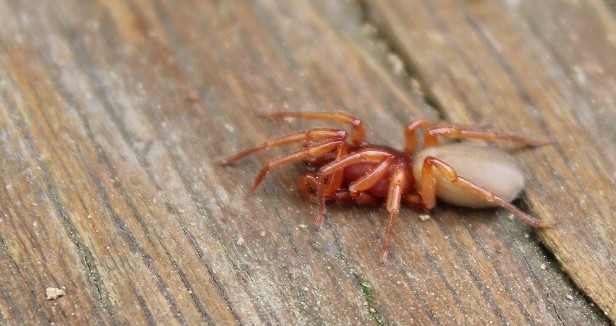I found a colorful and fairly large spider while removing the stump from  the mulberry in my yard. This is the same mulberry I wrote about earlier this year. (https://www.mercersmusings.com/2017/06/14/mulberry-is-open-for-business/)
the mulberry in my yard. This is the same mulberry I wrote about earlier this year. (https://www.mercersmusings.com/2017/06/14/mulberry-is-open-for-business/)
In July while replacing the split rail fence that wraps around my yard, I noticed the mulberry leaning dramatically towards the house. For the last few years, Eileen has been saying that the tree is covering more and more of our yard. Each year, I trimmed off a few more branches to keep the tree out of the phone line and to reduce the amount of shade the tree cast on the gardens. I assumed the branches closer to the house indicated the trees was growing. Oh, was I wrong! A large root had popped out of the ground (probably years ago) and rotted away. I could tell then that this tree would come down sometime soon. I made a note to take the tree down when we came back from our summer travels.

While we were travelling out west, I got a text that the tree did not wait. Remarkably, nothing was damaged other than ripping down the telephone line; an easy fix. We had someone remove the tree but they left the stump. After looking at that stump for the last month that we have been home, I decided to take the stump out. It was during the process of digging around the base of the stump that I spotted this spider about a half an inch long. It had a brick red cephalothorax (the body part on a spider where the legs attach) and legs, plus a tan, almost white abdomen.
Not recognizing this species of spider, I wanted a picture and the camera was inside the house. To keep it from getting away, I picked up the spider. Like most spiders, it moved around my gloved hand, but I noticed that once it reached my thumb, a place where it could be touched on both sides of its body, it stopped moving. Some animals feel safer when in close contact with their surroundings and being exposed makes them uncomfortable. The word for this is Trigmotaxis, which is when a plant or animal responds to the touch a solid body either positive or negative—move towards or away from.[1] Trigmo is Greek for touch and taxis means orderly arrangement. Examples of positive trigmotaxis include a vine responds to touching a tree or branch by moving towards it—allowing it to twine and climb. Moles feel safe in their tunnels. A mouse walks along a wall. Negative trigmotaxis examples include a root growing around a stone. This spider not only would stop moving once it felt the gentle pressure of my thumb and fingers, it pulled its legs tight against its body in what I would classify as a sheltering position.

Reaching the deck, I found myself in a quandary. Do I take the spider inside or leave it outside while I get the camera? Reasonably confident that my spider exhibited positive thigmotaxis behaviors and not certain if Eileen would welcome a large spider in the house if it escaped, I opted to leave it outside. I set it on the deck and gently place my work glove over top of it. Thankfully, the spider stayed put. When I removed the glove, the spider remained tucked up in a sheltering position for several seconds before running off. As I struggled with my camera trying to focus on a rapidly moving spider, I quickly figured out all I had to do was cover the spider with my glove for a short time, prepare my shot and remove the glove.
Before I got a decent picture, the spider crawled between two deck boards and returned to its sheltered position. I needed to coax it out and cover it with a glove again. I got a few pictures from various angles hoping I could figure out the species, but as soon as it broke from this curled up shelter position, it ran so fast I could not keep it in focus. Unfortunately, these pictures do not show the spider in its glory.
After taking a few pictures, I let it escape and went back to work.

After a hard day’s work on the stump, I downloaded the pictures onto my laptop, sorted out the clearest images and turned to www.bugguide.net. For starters, there are scads of spiders, so a lot of time was spent looking at pages of pictures. I eventually narrowed my search down to the broad-faced sac spider (Trachelas tranquilus)[2] or the woodlouse hunter (Dysdera crocta)[3], both commonly found in Pennsylvania. After comparing pictures, I realized the solution was in the jaws. Each time the spider was moving, I noticed this spider had honking huge chelicerae—jaws. The woodlouse hunter has BIG chelicerae for piercing the hard shell of the woodlouse, isopod, pillbug, roly-polly bug, or whatever else you want to call this spider’s preferred prey—bingo.
With a name, more information could be found.[4] I found it interesting that this species of spider, a non-native, came from Europe. Most often found in gardens and woodpiles, these spider have a close association with humans. All details that fit with my observations.
I must admit, that while I carried the spider around, those huge jaws gave me some concerned. Eventually, I learned, from my reading (as opposed to personal experience) the painful bite is not deadly or even of much concern. Once again, I am glad I did not test this detail.
So typical of my life, one task—removing a stump—drifts off into a natural history discovery—learning a new species of spider. Better yet, it happened right in my own backyard.
References
- https://www.thoughtco.com/thigmotaxis-definition-1968579
- https://bugguide.net/node/view/26291/bgpage – broad-faced sac spider
- https://bugguide.net/node/view/3388/bgpage – woodlouse hunter
- http://www.spiders.us/species/dysdera-crocata/

Comments
3 responses to “Spider Adventure”
So glad you let him go. I really don’t want to spider-sit next time you guys go out of town. He certainly is lovely, and I’m glad to
have met him.
thanks
Trigmotaxis is new to me; something to think about and observe. Thanks for sharing your quandary. When wandering the natural world I am often stumped as to the best behavior for me. Thank you, Bob, for this spider ID.